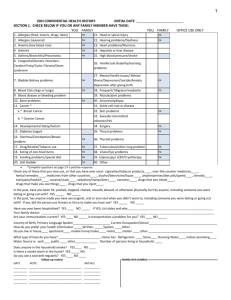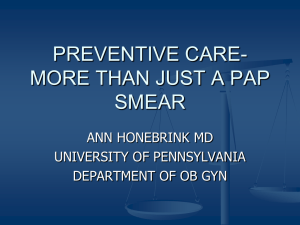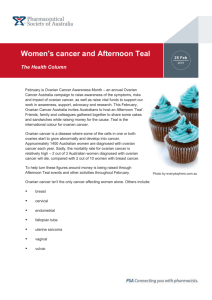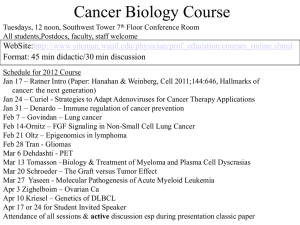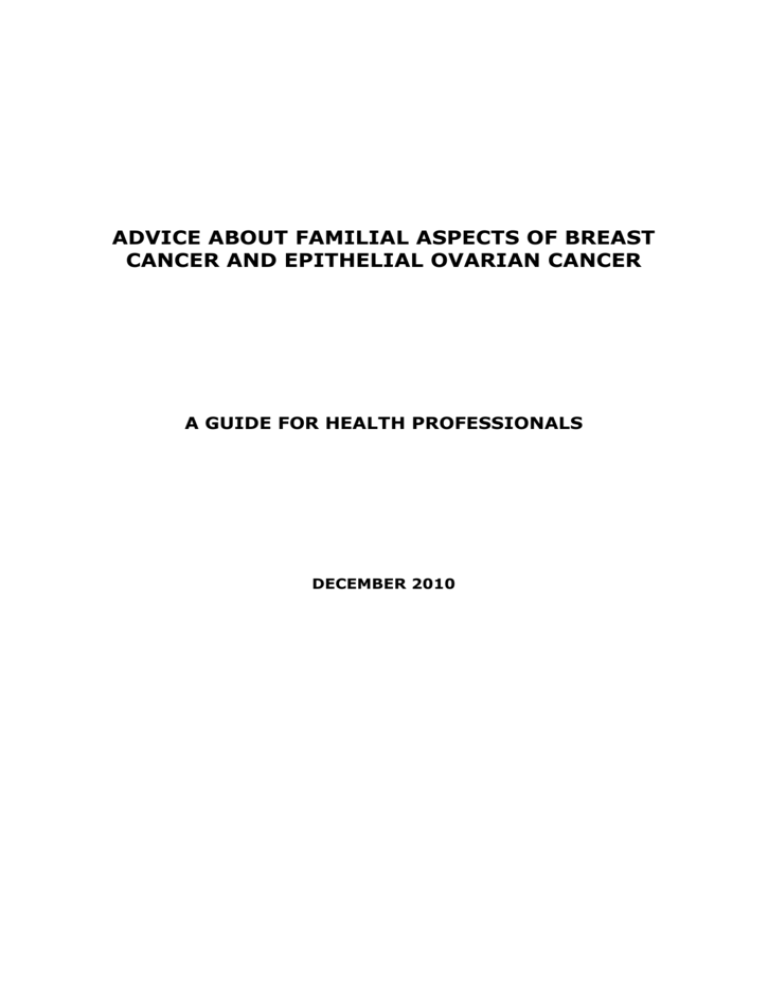
ADVICE ABOUT FAMILIAL ASPECTS OF BREAST
CANCER AND EPITHELIAL OVARIAN CANCER
A GUIDE FOR HEALTH PROFESSIONALS
DECEMBER 2010
The guide has been developed to cover familial aspects of both breast and epithelial
ovarian cancer.*
This guide is general guide for appropriate practice to be followed subject to the health
professional's judgement of each case. It is designed to provide information to assist
decisions made by health professionals and their patients. The guide is based on the best
available evidence or consensus opinion of experts where evidence does not exist at the
date of publication.
The information on page two can be used to determine an unaffected woman's risk of
developing breast cancer, based on her family history. The information on page three can
similarly be used to determine her risk of developing ovarian cancer.
To estimate the risk of a woman developing breast or ovarian cancer, based on family
history, with additional family history scenarios not covered in this guide, visit the
Familial Risk Assessment -Breast and Ovarian Cancer (FRA-BOC) on-line at
canceraustralia.gov.au/fraboc
In some families genetic testing can be used to assess risk. The availability, limitations,
potential benefits and possible consequences of genetic testing can be discussed at a
family cancer clinic.
This guide has three parts:
1.
Information for health professionals
2.
Tables which describe risk based on family history and current suggested
management
3.
Information for consumers that may be photocopied for distribution
Cancer Australia works to reduce the impact of cancer and improve the
wellbeing of people affected by cancer in Australia.
First edition published in December 2010 by National Breast and Ovarian Cancer Centre*
Second edition published in 2013 by Cancer Australia
Cancer Australia
Locked Bag 3, Strawberry Hills NSW 2012
Tel: 61 2 9357 9400 Fax: 61 2 9357 9477 Freecall: 1800 624 973
© Cancer Australia 2013
This work is copyright. You may download, display, print and reproduce this material in
unaltered form only (retaining this notice) for your personal, non-commercial,
educational and educational institutional use or use within your organisation. Apart from
any use as permitted under the Copyright Act 1968, all other rights are reserved.
* Note: Many of these cancers may originate in the fallopian tubes but they are managed as epithelial ovarian
cancer.
Information for women about family history of
breast cancer and ovarian cancer
Why does breast or ovarian cancer occur?
Sometimes some genes, which normally protect against cancer, develop a fault. This
causes the cells to grow out of control, leading to cancer. These genetic faults, which
occur throughout life, are not inherited. This occurs more often in older women. The
reasons for this are not yet fully understood.
What is a woman's chance of developing breast or
ovarian cancer?
All women have a chance of developing breast or ovarian cancer at some time during
their life. The risk of developing either cancer increases with age.
About 1 in 9 women will develop breast cancer before the age of 85
About 1 in 78 women will develop ovarian cancer before the age of 85
Most women who develop breast or ovarian cancer are over the age of 50.
What are the "risk factors" for breast and ovarian
cancer?
There are many things, called risk factors, which can increase a woman's chance of
developing breast or ovarian cancer.
Being female, increasing age and family history are the main risk factors.
What is meant by a family history of breast or ovarian
cancer?
A family history of breast or ovarian cancer means having one or more blood relatives
who have, or have had, breast or ovarian cancer. These relatives could be on either the
father's or mother's side of the family. Because breast cancer is common, many women
will have a family history by chance. However, some women with a family history may
have inherited a faulty gene which increases the risk of cancer. The women most likely to
have inherited a faulty gene are those with the strongest family history of breast or
ovarian cancer.
Understanding your family history of breast or ovarian cancer can provide an
indication of your chance of developing either disease:
most women have close to the average chance for the Australian population
some women have a moderately increased chance
a few women have a high chance
A woman could be at potentially high risk of developing either breast or ovarian cancer if
she has:
1.
Three or more close blood relatives on the same side of the family with breast or
ovarian cancer
OR
2.
Two or more close blood relatives on the same side of the family (mother's or
father's) with breast or ovarian cancer, plus one or more of the following features
on the same side of the family:
–
additional relative(s) with breast or ovarian cancer
–
breast and ovarian cancer in the same person
–
breast cancer before the age of 40
–
breast cancer in both breasts
–
breast cancer in a male relative
–
Jewish ancestry
OR
3.
Three or more close relatives on the same side of the family with colorectal
cancer, cancer of the uterus, gastric cancer and cancers involving the renal tract
(possible hereditary non-polyposis colorectal cancer or Lynch Syndrome)
OR
4.
A family member who has had a genetic test that has shown that he or she has an
inherited fault in a gene associated with breast or ovarian cancer.
Inheriting a breast or ovarian cancer gene fault
Breast or ovarian cancer caused by inheriting a faulty gene is called hereditary cancer.
We all inherit a set of genes from each of our parents. Sometimes there is a fault in one
copy of a gene which stops that gene working properly. This fault is called a mutation.
There are several genes for which inherited faults may be involved in the development of
breast or ovarian cancer. These are genes which normally prevent a woman developing
breast or ovarian cancer.
Some of these are genes that you may have heard of are called BRCA1 and BRCA2. Their
names come from the abbreviation of "breast cancer one" and "breast cancer two". If a
woman has inherited a fault in one of these genes, she has a high chance of developing
breast or ovarian cancer; although it does not mean that she is certain to develop
cancer.
Around 5% of all breast cancers and up to 15% of invasive ovarian cancers can be
explained by an inherited gene fault in BRCA1 or BRCA2.
A woman who has had a gene fault in BRCA1 or BRCA2 found through genetic testing is
at high risk of developing breast or ovarian cancer. Men can also carry these gene faults.
Early detection - what you can do
The earlier that cancer is found the more successful the outcome is likely to be.
Therefore, it is recommended that:
Breast cancer
women of all ages, regardless of whether they attend for mammographic
screening, are aware of how their breasts normally look and feel and promptly
report any new or unusual changes to their general practitioner.
women 50-69 years attend the BreastScreen Australia program for free screening
mammograms every two years. Women aged 40-49 years are also eligible for this
Program, but population mammographic screening is not recommended for
women younger than 40 years. For more information visit BreastScreen
Australia at cancerscreening.gov.au. For a BreastScreen appointment ring 13
20 50 from anywhere in Australia.
Women at high risk of breast cancer may be advised to begin screening at a
younger age, and at more frequent intervals, than those at population risk.
Ovarian cancer
women consult their GP if they have persistent symptoms that are unusual for
them such as abdominal or pelvic pain, bloating, unexplained weight gain or loss,
or fatigue.
In addition, for women with a family history
Women concerned about their family history can talk to their general practitioner. It may
be appropriate for some women with a strong family history to be referred to a family
cancer clinic. These clinics can:
provide information about a person's risk of developing cancer
give an estimate of the likelihood of carrying an inherited mutation in a cancerpredisposing gene
provide advice about possible strategies that might help reduce the risk of cancer
provide counselling and support y discuss what medical check-ups may be
appropriate
if appropriate, discuss the limitations, potential benefits, and possible
consequences of genetic testing.
Advice about familial aspects of breast cancer and
ovarian cancer
Assessing family history
Family history of breast or ovarian cancer can be used to estimate:
a woman's risk of developing these cancers
the probability of having an inherited mutation in a known cancer-predisposing
gene.
Key factors associated with increased risk include:
multiple relatives affected by breast (male or female) or ovarian cancer
young age at cancer diagnosis in relatives
relatives affected by both breast and ovarian cancer
relatives affected with bilateral breast cancer
Ashkenazi Jewish ancestry.
Taking a family history
Consider relatives on each side of the family separately.
An accurate family history should include:
asking the woman about any primary cancer in all 1° (parents, siblings, children)
and 2° (aunts, uncles, nieces, nephews, grandparents) relatives on both sides of
the family
establishing the site and age at diagnosis of the cancer(s)
confirming, if possible, reports of cancer in relatives - a person's knowledge of
their family history may be inaccurate
updating the family history regularly - it may change with time.
Which genes are associated with a predisposition to
breast or ovarian cancer?
Women born with a mutation in one of several known genes (see Table 2) have an
increased risk of breast and/or ovarian cancer.
There may be other genes, as yet undiscovered, in which mutations are also associated
with a risk of breast or ovarian cancer.
The women most likely to have inherited a mutation are those with the strongest family
history of breast or ovarian cancer.
Breast cancer
One in 9 Australian women develops breast cancer before the age of 85. In 2006 breast
cancer was second most common cause of cancer death in Australian women.
Ovarian cancer
One in 78 Australian women develops epithelial ovarian cancer before the age of 85.
Ovarian cancer is the leading cause of death from gynaecological malignancy.
NB: The average life expectancy of Australian women is 84 years. For key statistics about
breast and ovarian cancer see www.canceraustralia.gov.au
Family cancer clinics
Family cancer clinics provide a service for people with a family history of cancer and their
health professionals. The service is offered to any family members, whether or not they
have been diagnosed with cancer. After assessing detailed information about a woman's
family history of cancer, these clinics provide genetic counselling including:
information about a person's risk of developing cancer based on family history and
other relevant factors
advice about strategies that reduce the risk of cancer
information about early detection of cancer
an estimate of the likelihood of carrying an inherited mutation in a cancerpredisposing gene
if appropriate, the offer of genetic testing.
Genetic testing
It is possible to detect mutations in some cancer-predisposing genes. Some mutations
may not be detected using current technology.
Testing involves first searching for a gene mutation, usually in a blood sample from an
affected family member. Should a mutation be found, testing may then be offered to
other adult relatives who may carry the same mutation. Genetic testing is offered only
with pre- and post-test counselling to discuss the limitations, potential benefits, and
possible consequences.
For a list of family cancer clinics see canceraustralia.gov.au/fraboc
Risk factors for breast and ovarian cancer
The main risk factors for breast and ovarian cancer are:
being female
increasing age
family history.
Family history does not necessarily imply an inherited genetic cause. However, at least
1% to 5% of breast cancers and up to 15% of all cases of invasive ovarian cancer involve
the inheritance of a mutated gene.
The vast majority of affected women do not carry an inherited mutation in a known
breast or ovarian cancer-predisposing gene.
Table 1: Approximate risk of developing breast or ovarian cancer in the next 10
years (NBOCC 2005).
If the woman is now aged
Her risk in the next 10 years
Breast
Her risk in the next 10 years
Ovarian
20
1 in 2500
1 in 3000
30
1 in 250
1 in 2000
40
1 in 70
1 in 900
50
1 in 40
1 in 450
60
1 in 30
1 in 300
70
1 in 30
1 in 200
20
1 in 2500
1 in 3000
Table 2. Genes for which mutations are known to be associated with an
inherited predisposition to breast or ovarian cancer and possibly cancer at other
sites.
Gene
Mutation
Frequency
Major sites at risk
Risk to age 75 in
mutation carriersd
Other possible sites
with up to 10%
lifetime risk
BRCA1
~1/1000a
Breast
40% - 80%
Prostate
Ovary
10% - 60%
Breast
40% - 80%
Ovary
10% - 40%
Breast
>50%
Bone or Soft tissue
10% - 50%
Large bowel
50% - 80%
Uterus
40%
BRCA2
Tp53b
Mismatch
repair genes
(MMR)c
~1/1000a
~1/10,000
~1/1000
Male breast, prostate,
pancreas
Brain, lung, adrenal
gland, haematological
and other
Ovary, other gastrointestinal, renal tract
a. ~1/100 for individuals of Jewish descent. b. This syndrome is commonly referred to as the Li-Fraumeni
syndrome. c. This syndrome is commonly referred to as hereditary non-polyposis colorectal cancer (HNPCC) or
Lynch Syndrome. d. There is a wide range of risk associated with mutations in these genes.
Advice about familial aspects of breast cancer
The following categorisation applies to women without breast or ovarian
cancer:
1. At or slightly above average risk
Categories of risk
Management
Covers more than 95% of the female
population
Clarify risk. See canceraustralia.gov.au/fraboc
Advise risk is similar to that of the general
population
Reassure that 9 out of 10 women in this
group will not develop breast cancer Inform
that breast cancer risk increases with age
(see Table 1)
BreastScreen Australia provides free
screening mammograms every two years
from age 40. Call 13 20 50 for an
appointment
Discuss modifiable risk factors for breast
cancer. See canceraustralia.gov.au/risk
Encourage all women to be aware of the
normal look and feel of their breasts and
promptly report persistent or unusual
changes to their GP Investigate women with
symptoms using the Triple Test. (See The
investigation of a new breast symptom,
National Breast Cancer Centre (NBCC),*
2006)
As a group, risk of breast cancer up to age 75 is
between 1 in 11 and 1 in 8. This risk is no more than
1.5 times the population average.
No confirmed family history of breast cancer
One 1° relative diagnosed with breast
cancer at age 50 or older
One 2° relative diagnosed with breast
cancer at any age
Two 2° relatives on the same side of the
family diagnosed with breast cancer at age
50 or older
Two 1° or 2° relatives diagnosed with
breast cancer, at age 50 or older, but on
different sides of the family (i.e. one on
each side of the family).
2. Moderately increased risk
Categories of risk
Management
Covers less than 4% of the female population
Clarify risk. See canceraustralia.gov.au/fraboc
As a group, risk of breast cancer up to age 75 is
between 1 in 8 and 1 in 4. This risk is 1.5 to 3 times
the population average.
Advise that there is a moderately increased
risk of developing breast cancer
Reassure that most of the women in this
group will not develop breast cancer
Advise the woman to attend BreastScreen for
regular screening mammograms
Advise that a more precise risk assessment
and management plan is available from a
family cancer clinic or specialist cancer clinic.
One 1° relative diagnosed with breast
cancer before the age of 50 (without the
additional features of the potentially highrisk group - see category 3)
Two 1° relatives, on the same side of the
family, diagnosed with breast cancer
(without the additional features of the
potentially high-risk group -see category 3)
Two 2° relatives, on the same side of the
family, diagnosed with breast cancer, at
least one before the age of 50, (without the
additional features of the potentially highrisk group - see category 3).
Additional surveillance
Annual mammograms from age 40 may be
recommended if the woman has a first degree
relative < 50 years diagnosed with breast
cancer. Referral to a family cancer clinic may
be appropriate
Annual mammograms are not recommended
for women with a single relative diagnosed >
50 years, as there is no clear evidence of
benefit
In women over 35 years of age, consider the
use of medication, such as tamoxifen or
raloxifene, to reduce risk of developing breast
cancer This requires careful assessment of
risk and benefits in the individual case by an
experienced medical professional
Discuss possible participation in a relevant
clinical trial for risk reduction/prevention of
breast cancer See
www.australiancancertrials.gov.au,
www.anzctr.org.au, www.anzbctg.org.au
Discuss modifiable risk factors for breast
cancer. See canceraustralia.gov.au/risk
Encourage all women to be aware of the
normal look and feel of their breasts and
promptly report persistent or unusual
changes to their GP
Investigate women with symptoms using the
Triple Test.
3. Potentially high risk
Categories of risk
Management
Covers less than 1% of the female population
Clarify risk. See canceraustralia.gov.au/fraboc
As a group, risk of breast cancer up to age 75 is
between 1 in 4 and 1 in 2. Risk may be more than 3
times the population average. Individual risk may be
higher or lower if genetic test results are known.
Advise that although there is a high or
potentially high risk of developing breast
cancer, and perhaps other cancers, many
women in this group will not develop breast
cancer
Advise referral to a family cancer clinic for
risk assessment, possible genetic testing and
management plan
Women who are at potentially high risk of
ovarian cancer (See page 3)
Two 1° or 2° relatives on one side of the
family diagnosed with breast or ovarian
cancer plus one or more of the following on
the same side of the family:
Discuss risk reduction strategies which may
include:
–
additional relative(s) with breast or
ovarian cancer
–
breast cancer diagnosed before the
age of 40
–
bilateral breast cancer
–
breast and ovarian cancer in the
same woman
–
Jewish ancestry
–
breast cancer in a male relative.
One 1° or 2° relative diagnosed with breast
cancer at age 45 or younger plus another 1°
or 2° relative on the same side of the family
with sarcoma (bone/soft tissue) at age 45
or younger
Member of a family in which the presence of
a high-risk breast cancer gene mutation has
been established.
Risk-reducing surgery
Consideration of the use of medication, such as
tamoxifen or raloxifene, to reduce risk of developing
breast cancer
Ongoing surveillance strategies which may
include:
Regular clinical breast examination
Annual breast imaging with mammography, MRI or
ultrasound
Consideration of ovarian cancer risk (see page 3).
Discuss possible participation in a relevant
clinical trial for risk reduction/prevention of
breast cancer For available trials see
www.australiancancertrials.gov.au,
www.anzctr.org.au, www.anzbctg.org.au
Discuss modifiable risk factors for breast
cancer. See canceraustralia.gov.au/risk
Encourage all women to be aware of the
normal look and feel of their breasts and
promptly report persistent or unusual
changes to their GP
Investigate women with symptoms using the
Triple Test.
Advice about familial aspects of ovarian cancer
1. At or slightly above average risk OR 2. Moderately increased risk
Categories of risk
Management
Covers more than 99% of the female
population
Advise that risk is similar to the rest of the
population
Reassure that more than 9 out of 10 women
in this group will not develop ovarian cancer
Inform that evidence does not support
screening women in this group with
ultrasound or CA125.
As a group, risk of ovarian cancer up to age
75 is between 1 in 100 and 1 in 30. This risk
is no more than 3 times than the population
average
No confirmed family history of epithelial
ovarian cancer
One 1° or 2° relative diagnosed with
ovarian cancer at any age (provided the
family is not of Ashkenazi Jewish ancestry1
and does not have any additional cases of
breast cancer)
Two 1° or 2° relatives diagnosed with
ovarian cancer, but on different sides of the
family (i.e. one on each side of the family).
Note: If a woman reports a family history of epithelial
ovarian cancer between the ages of 35 and 50,
consider referral to a family cancer
3. Potentially high risk
Categories of risk
Management
Covers less than 1% of the female population
As a group, risk of ovarian cancer up to age 75 is
between 1 in 30 and 1 in 2. This risk is more than 3
times the population average. Individual risk may be
higher or lower if genetic test results are known.
Advise there is a high /potentially high risk of
developing ovarian cancer, and perhaps other
cancers such as breast, bowel or endometrial
cancer
Advise referral to a family cancer clinic for
risk assessment, possible genetic testing and
management plan
Discuss risk management strategies
Women who are at high risk of breast
cancer due to a gene fault
One 1° or 2° relative diagnosed with
epithelial ovarian cancer in a family of
Ashkenazi Jewish ancestry 1
One 1° or 2° relative with ovarian cancer at
any age, and another with breast cancer
before the age of 50, where the women are
1° or 2° relatives of each other
Two 1° or 2° relatives on the same side of
the family diagnosed with epithelial ovarian
cancer, especially if one or more of the
following features occurs on the same side
of the family:
–
additional relative(s) with breast or
ovarian cancer
–
breast cancer diagnosed before the
age of 40
–
bilateral breast cancer
–
breast and ovarian cancer in the
same woman
–
breast cancer in a male relative.
Three or more 1° or 2° degree relatives on
the same side of the family diagnosed with
a family history suggestive of Lynch
Syndrome (or HNPCC) e.g. colorectal cancer
(particularly if diagnosed before the age of
50), endometrial cancer, ovarian cancer,
gastric cancer, and cancers involving the
renal tract
Member of a family in which the presence of
a high-risk ovarian cancer gene mutation
has been established.
–
Risk-reducing surgery. The most
effective risk-reducing strategy for
ovarian cancer is bilateral salpingooophorectomy (BSO). (NB: BSO also
reduces breast cancer risk when
done before age 40)
–
Chemoprevention (Use of medication
to prevent ovarian cancer). Use of
the oral contraceptive pill (OCP) may
be an option for pre-menopausal
women who choose not to have riskreducing surgery. The impact on
breast cancer risk for mutation
carriers is unclear
Ovarian cancer surveillance is not
recommended for women at high or
potentially high risk. Evidence shows that
ultrasound or CA125, singly or in
combination, is not effective at detecting
early ovarian cancer
Discuss surveillance relevant to other cancers
(e.g. attending for clinical breast
examination, mammography for breast
cancer; or other surveillance, if the family
cancer history is consistent with Lynch
Syndrome)
Discuss possible participation in a relevant
clinical trial. For information about possible
trials see www.australiancancertrials.gov.au,
www.anzgog.org.au.
High-risk ovarian and breast gene mutations are more common in people of Ashkenazi Jewish ancestry. *In
February 2008, National Breast Cancer Centre incorporating the Ovarian Cancer Program (NBCC) changed its
name to National Breast and Ovarian Cancer Centre (NBOCC)
1

